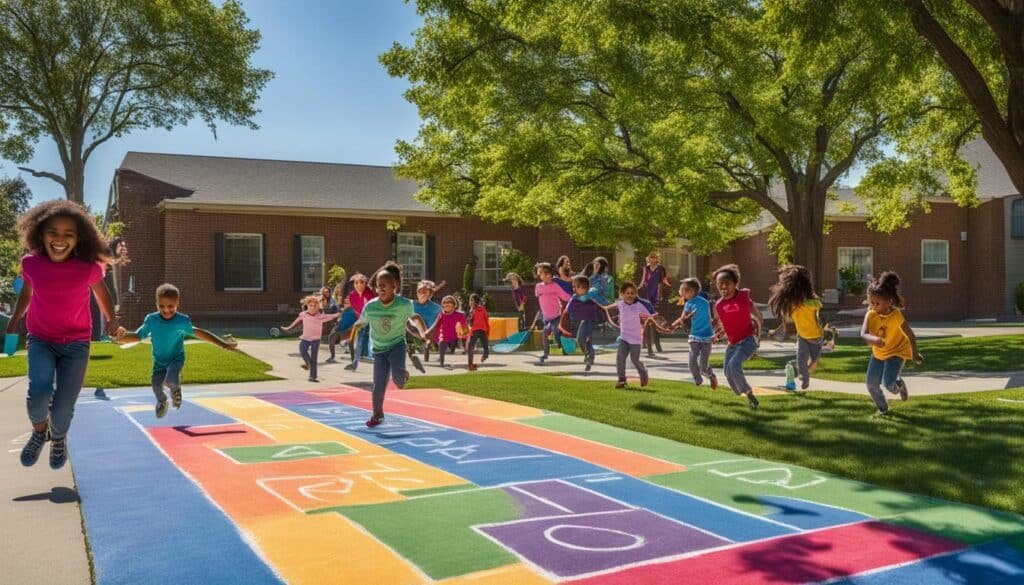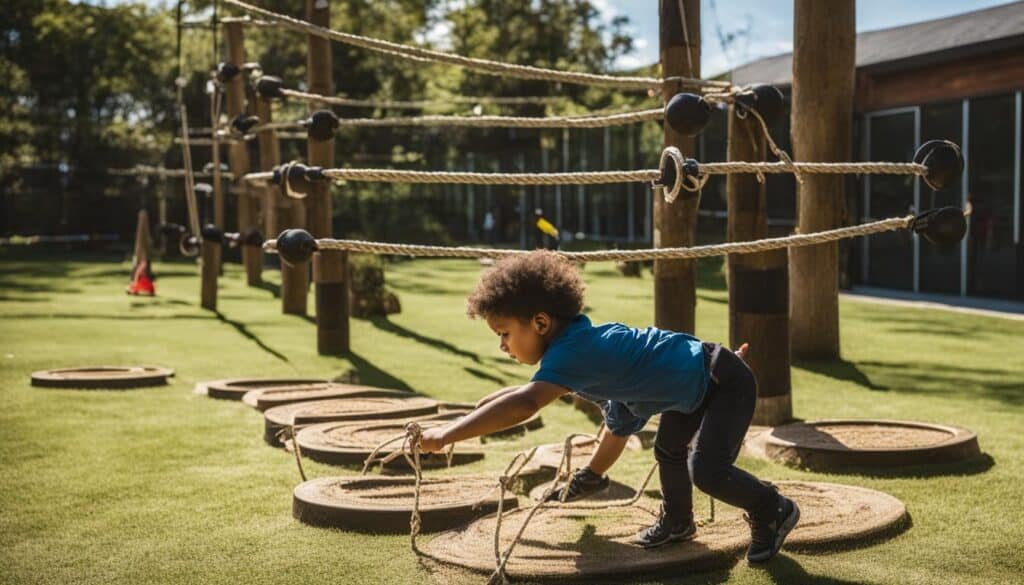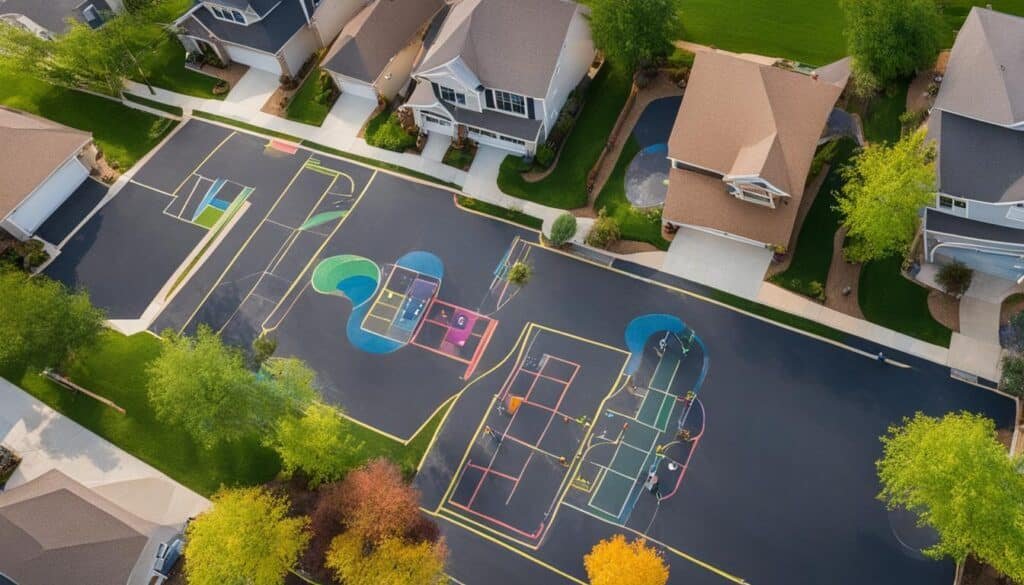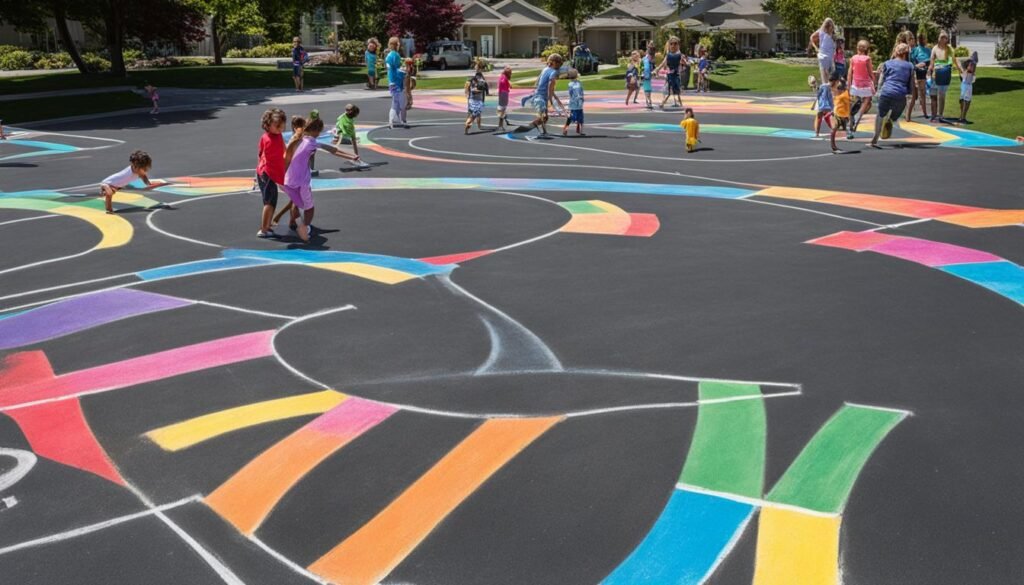Transform your driveway or sidewalk into an engaging, kid-friendly playground with a chalk obstacle course. Not only does this creative outdoor activity promote physical movement and imaginative play, but it also offers a cost-effective and environmentally-safe alternative to traditional toys. In this guide, we will explore the many benefits of chalk obstacle courses, including their versatility, interactivity, and potential for educational development. So, let’s dive in and learn how to create an unforgettable DIY obstacle course that will provide hours of fun for the whole family!
Also Read: Mastering The Squirrel Obstacle Course: A Fun Guide
Key Takeaways
- Chalk obstacle courses are perfect for outdoor activity, providing interactive and engaging play that can be easily adapted for various age groups.
- Creating a DIY obstacle course is a simple and cost-effective way to entertain and educate kids in a kid-friendly fun environment.
- This activity promotes creative outdoor play by allowing kids to unleash their artistic talents and exercise their minds and bodies simultaneously.
- Integrating educational elements into the chalk obstacle course can expand its benefits and cater to diverse learning styles.
- Driveway games and sidewalk chalk courses can help build social connections within the community by inviting friends and neighbors to join the fun.
Unleashing Creativity with Sidewalk Chalk
Sidewalk chalk serves as a tool to unleash creativity among children and adults alike. The simple action of drawing on pavements transforms into a complex canvas where imagination defines the limits. From depicting stick figures that prompt certain movements to designing courses that involve intricate patterns and rules, sidewalk chalk encourages the creator to be inventive.
Also Read: Experience Excellence At West Hill Golf Course – A Golfer’s Paradise
Adding personal flair and crafting new, unique actions tailored to one’s family results in a distinctive form of expression that is not only visually stimulating but also encourages physical activity. Let’s explore some chalk obstacle course ideas that combine sidewalk chalk creativity with engaging chalk games, inventive chalk activities, and kids’ imaginative play:
- Follow-the-line: Draw a winding, curvy line for kids to walk, run, or hop along.
- Shape-jump: Create a series of shapes (circle, square, triangle) and have children jump from one shape to another.
- Alphabet hop: Draw large letters of the alphabet on the pavement and encourage kids to hop from one letter to another, spelling out words.
- Chalk maze: Design a simple or intricate chalk maze for children to navigate.
- Agility ladder: Create a ladder pattern on the sidewalk for kids to quickly step in and out of, practicing their speed and agility.
Building on sidewalk artistry, consider including drawings of animals, objects, or nature scenes to enhance the visual appeal and boost the imaginations of the participants. Encourage children to contribute their artwork as well, setting their creativity free.
“Every child is an artist. The problem is how to remain an artist once we grow up.” – Pablo Picasso
Remember, the true impact of sidewalk chalk lies in its versatility. By embracing a variety of chalk obstacle course ideas, incorporating unique elements, and continuously adapting the activities, parents can stimulate children’s imaginations and promote inventive chalk activities that foster both creativity and healthy outdoor play.
Choosing Your Canvas: Driveways and Sidewalks
When selecting a space for your chalk course, it is essential to find the perfect location to ensure a fun and successful experience. A proper sidewalk canvas provides a secure play space, optimal chalk course area, and ensures the chalk obstacle course safety. Driveways and sidewalks are great places to begin your search for the ideal location.
Also Read: Master Accounting With Top Online CPA Courses: Get Certified
Scoping Out the Perfect Space
When choosing an area for your driveway chalk art and sidewalk obstacle course, consider factors such as evenness of the surface and area size. These aspects play a crucial role in ensuring the activity can cater to various age groups and skill levels, as well as determining the overall complexity of the course. Analyzing your available spaces, consider the following checklist:
- Smooth and even surface: Avoid areas with potholes or cracks that may cause trips or falls.
- Size of the area: A larger space allows for more complexity and can accommodate longer courses.
- Vibrant and visible colors: This ensures the course can be seen by the participants, making it more engaging.
- Accessibility: Easy access for all participants, including those with disabilities.
Safety Considerations for High-Traffic Areas
When planning a chalk obstacle course in high-traffic sidewalk activities, safety should always be a top priority. To ensure the safety of participants, aim to select spaces that are not frequently used by vehicles or by people walking by. Doing so minimizes the risk of accidents occurring and ensures an enjoyable experience for everyone involved.
It’s crucial to select spaces that are not frequently used by vehicles so as to not disrupt playtime and ensure the safety of participants.
In cases where your chosen space is near vehicular traffic, consider these preventative measures:
- Designate a “lookout” who watches for approaching vehicles and alerts the participants if needed.
- Avoid placing the course close to the edge of the sidewalk or driveway, giving participants enough space to react if necessary.
- If possible, choose a time when the area has less traffic, such as early morning or late evening.
In conclusion, selecting the perfect space for your chalk obstacle course is essential for ensuring a fun, safe, and engaging experience for all participants. By taking into account factors such as surface conditions, area size, accessibility, and safety concerns, you can enjoy a bustling and creative sidewalk canvas that offers endless possibilities.
Incorporating Educational Elements into Chalk Obstacle Courses

Chalk obstacle courses provide endless opportunities to turn learning through play into reality. By including various educational elements in the design, children are encouraged to engage in cognitive challenges while on the move. This blended approach of kinesthetic activity and mental exercises caters to different learning styles and keeps the experience both fun and stimulating.
Also Read: Experience Challenge And Fun At Triple Lakes Golf Course
Here are some ideas for educational chalk activities that can be seamlessly integrated into your obstacle course:
-
- Incorporate letters and numbers throughout the course, prompting children to identify and pronounce them as they progress.
- Assign simple math problems or word-building tasks that need to be solved before moving on to the next section of the course.
- Introduce basic geometric shapes or spatial concepts like “above,” “below,” “beside,” etc., to teach spatial awareness and critical thinking.
- Use colored zones or lines to indicate tasks related to color recognition and sequencing.(“
)
“Including educational elements in your chalk obstacle course not only stimulates the mind, but helps children develop a love for learning.”
As children engage in these chalk games for kids, they practice problem-solving skills, critical thinking, and memory retention, all while enjoying their playtime. Sidewalk chalk learning can be a subtle but powerful way to promote educational development in a relaxed, outdoor environment.
| Age Group | Educational Elements |
|---|---|
| 3-5 years old | Letter and number recognition, color identification, basic shapes |
| 6-8 years old | Word-building, basic math problems, simple spatial concepts |
| 9-12 years old | More complex math problems, advanced spatial concepts, sequencing and patterns |
Remember, the key is to strike a balance between education and enjoyment. Whether you’re developing a chalk obstacle course for your own children or organizing a group activity for the neighborhood kids, incorporating educational elements into the design helps transform playtime into a valuable learning experience. It’s time to let your creativity shine and make learning fun with sidewalk chalk!
Boosting Gross Motor Skills Through Play

Sidewalk chalk obstacle courses serve as an excellent means to enhance gross motor skills among children. By directing them to perform diversified movements like hopping, running, or twisting, these courses promote balance, coordination, and overall physical agility.
Also Read: Explore Nova Southeastern University Degrees & Programs
Designing Movement Challenges for Coordination
To create an engaging and effective movement challenge for kids, it is essential to incorporate a variety of activities that encourage the development of coordination and balance. These activities should be age-appropriate and designed to foster gross motor skills through play. Here are some suggestions to consider when designing movement challenges:
- Jumping and hopping: Incorporate a series of numbered squares or circles, prompting children to jump or hop from one to the next in a specified sequence.
- Skipping: Encourage children to skip from one designated point to another, following a zig-zag pattern or a straight line.
- Twisting and turning: Integrate some twister-style challenges using colored circles or shapes, requiring children to place their hands or feet on specified spots.
- Balancing: Create a narrow line or path for children to walk across, simulating a balance beam.
- Crawling: Set up a low obstacle, such as a chalk-drawn tunnel or table-shaped drawing, prompting kids to crawl their way through.
“Designing movement challenges not only helps children develop coordination and balance but also promotes problem-solving and critical thinking, as they strategize the best way to navigate the course.”
Table 1 below illustrates a few examples of various activities and their corresponding benefits in terms of coordination and gross motor skill development:
| Activity | Gross Motor Skill Developed | Coordination Benefit |
|---|---|---|
| Jumping and hopping | Power | Lower body coordination |
| Skipping | Agility | Upper and lower body coordination |
| Twisting and turning | Flexibility | Whole body coordination |
| Balancing | Balance | Core strength and stability |
| Crawling | Strength | Upper body and lower body coordination |
Demonstrating and instructing children on how to navigate the course can aid in their understanding and execution of movements, thereby facilitating motor skill development in a play-based context. With constant practice and adaptation, children can significantly improve their coordination and gross motor skills while having fun with chalk obstacle courses.
DIY Chalk Obstacle Course Design: Where to Start?

Embarking on a DIY chalk obstacle course design is as easy as gathering a few materials and scouting out the perfect space. With only an assortment of sidewalk chalks at hand, a clear driveway or sidewalk is all that is required to commence drawing the course. The use of vibrant colors amplifies the visual appeal, while incorporating a wide array of movements and tasks ensures the obstacle course remains dynamic and enjoyable for participants. The simplicity of creation allows for constant re-imagination and adaptation of the courses to suit the players’ evolving interests.
To start your chalk obstacle course, the only tools you need are sidewalk chalk and a clear space!
Follow these simple homemade obstacle course setup steps to create an engaging and entertaining DIY chalk obstacle course:
- Select an appropriate location for your course, ensuring the surface is even and large enough to accommodate your design.
- Gather your sidewalk chalk collection, ensuring a variety of colors are available for maximum visual impact.
- Begin by drawing a starting point, and then proceed by creating a sequence of movement tasks, educational elements, and creative challenges that cater to the interests and abilities of the participants.
- Periodically update the course design to keep it fresh and appealing, incorporating new elements or themes as desired.
Here is a sample chalk obstacle course layout to spark your creativity:
Twist around in a circle
| Station Number | Movement Task | Educational Element | Creative Challenge |
|---|---|---|---|
| 1 | Jumping jacks | Count aloud | Draw the number of jumps completed |
| 2 | Hopscotch | Identify shape at the end | Add a colorful border to the shape |
| 3 | Lunges | Spell a word with each step | Create a custom letter path for lunges |
| 4 | Recognize colors in sequence | Design a colorful spiral pattern |
By following the steps above, you’re well on your way to designing a one-of-a-kind chalk obstacle course that offers endless opportunities for fun and learning.
Chalk Challenges and Games for Every Age Group

Chalk obstacle courses are versatile and inclusive forms of play that cater to a wide range of age groups and developmental stages. By tailoring age-appropriate chalk challenges for kids and ensuring that multi-age sidewalk games are engaging and accessible, these activities ensure that every participant can derive enjoyment and growth from the experience.
For younger children, the emphasis can be placed on simpler elements like stick figures and basic shapes as action prompts in their chalk games. These foundational drawings encourage fundamental movement skills and lay the groundwork for more advanced challenges as they grow older. Some examples of age-appropriate chalk games for young kids include:
- Hopscotch
- Chalk Lavawalk
- Jumping path
- Shape tracing and identification
For older kids, more complex tasks can be incorporated into the courses, like combining movement sequences with spelling words or solving puzzles. This fusion of physical and cognitive activities stimulates both body and mind, promoting a holistic developmental experience. A few examples of inclusive chalk activities for older children can consist of:
- Maze solving
- Spell-and-jump word challenge
- Chalk obstacle races
- Timed math problem sprints
By differentiating the activities based on individual capabilities and age-specific needs, chalk obstacle courses can provide an engaging and supportive learning environment for all participants.
Outdoor Chalk Activities That Engage and Entertain

Outdoor chalk activities provide opportunities for individuals with diverse skill levels to be engaged and entertained. The adaptability of these activities means that participants of varying physical and cognitive abilities can find joy and challenges tailored to their capabilities. Let’s explore how such activities can be customized to suit a broad audience and enhance the connection between art and exercise in outdoor play.
Adapting the Course for Diverse Skill Levels
To cater to different abilities in chalk games, creators can vary the course’s complexity, length, and types of tasks incorporated. Designing obstacle courses that allow for modifications enables inclusivity, enhancing the engagement and entertainment value for a broad audience. Below are some examples of adaptable outdoor chalk play activities:
- Easy exercises: Incorporate simple actions like hopping, jumping, or walking to cater to younger children or individuals with limited physical abilities.
- Intermediate challenges: Introduce more complex tasks such as balancing on one leg, squatting, or following zigzag paths for individuals with moderate physical capabilities.
- Advanced activities: Include higher intensity actions like moving in specific patterns, leaping, or performing a combination of exercises within a set timeframe for more physically adept individuals.
Fusing Art and Exercise in Outdoor Play
Combining art with exercise in outdoor activities creates a unique mode of play that enriches both the mind and the body. The essence of sidewalk chalk obstacle courses lies in their ability to fuse artistry with physical exertion, making each course as much a creative expression as it is a playground for exercise. Participants are given the freedom to blend their artistic sensibilities with the functional needs of the course, fostering creative physical chalk activities and artistic outdoor exercise.
“You can’t use up creativity. The more you use, the more you have.” – Maya Angelou
Playful art integration in outdoor activities can be achieved by:
- Drawing colorful paths, shapes, and tasks using sidewalk chalk.
- Incorporating various artistic mediums, such as paint or colored sand alongside the chalk in outdoor activities.
- Encouraging participants to add their personal artistic flair and unique ideas to the course design.
Engaging in these creative sidewalk chalk activities not only invigorates physical exercise but also promotes mental and emotional well-being, making it an ideal choice for outdoor entertainment.
Community Building with a Sidewalk Chalk Obstacle Course

A sidewalk chalk obstacle course has the potential to act as a catalyst for community building, as neighbors and friends can be invited to partake in the fun. This community engagement chalk course fosters social connections within the community through collective outdoor play and group chalk activities. By engaging multiple participants, these courses transform into joint ventures that reinforce a spirit of camaraderie and shared enjoyment.
Inviting Neighbors to Join the Fun
Extending an invitation for neighbors to join in on the chalk obstacle course fun enables a sense of unity, making it a neighborly chalk game that enhances relationships and promotes community bonding. Here are some ideas on how to engage your neighbors in the chalk obstacle course experience:
- Organize a community chalk obstacle course day where multiple households create their courses and encourage friendly competition.
- Invite the neighborhood kids to collaborate on a large, joint chalk obstacle course that spans multiple properties or a shared community space.
- Designate a day of the week for collective chalk artistry and obstacle course building, providing an opportunity for neighbors to come together regularly and enjoy outdoor physical activities.
- Create themed courses for holidays or local events and invite neighbors to contribute to the design and execution of the obstacle course.
Successfully integrating sidewalk chalk obstacle courses into your community creates a fun, inclusive, and engaging environment that helps build lasting connections among neighbors. Participation in collective outdoor play not only encourages physical activity and artistic expression but also nurtures lasting friendships and a sense of belonging within the community.
Keeping Your Chalk Obstacle Course Fresh and Exciting
To maintain the novelty and excitement of a chalk obstacle course, it is essential to regularly infuse new elements and challenges into the design. This can be achieved through several strategies, such as changing patterns, incorporating seasonal or themed motifs, or simply altering the sequence of tasks. Involving the children in the creation process can also generate fresh perspectives and enhance their sense of ownership and inventiveness.
Here are some approaches to keep your chalk obstacle course engaging and consistently interesting:
- Switching up the patterns: Experiment with new patterns, designs, and shapes within the obstacle course. This not only refreshes the visual appeal but also stimulates different muscle groups and cognitive functions.
- Incorporating seasonal or themed motifs: Update your chalk obstacle courses to reflect different seasons, holidays, and events. For instance, include festive elements during Christmas or spooky elements during Halloween.
- Altering the sequence of tasks: Rearrange the order of tasks within the obstacle course to keep participants guessing and maintain excitement.
- Introducing new challenges: Research and incorporate innovative chalk obstacle ideas to challenge participants and keep them engaged.
- Involving children in the creation process: Encourage your children to contribute their ideas and artistic talents in designing the obstacle course, fostering a sense of ownership and creativity.
Beyond these approaches, there are additional benefits to be gained from regularly updating a chalk obstacle course:
| Benefit | Description |
|---|---|
| Adaptability | Refreshing the course allows it to evolve and adapt to the changing interests, abilities, and needs of its participants. |
| Engagement | Maintaining an engaging chalk course helps retain the enthusiasm of participants and fosters long-term enjoyment. |
| Skill Development | Introducing new challenges encourages the development of physical, cognitive, and creative skills among participants. |
| Community Involvement | Regular chalk course renewal invites broader community participation and camaraderie, creating a shared activity for all to enjoy. |
Ultimately, keeping your chalk obstacle course fresh and exciting requires a commitment to innovation, flexibility, and inclusiveness. Regularly updating and refining the course design ensures continued engagement and fosters a dynamic, rewarding experience for all participants.
Conclusion
In summary, a chalk obstacle course serves as an engaging outdoor activity that combines creative expression with physical movement. Offering various benefits, chalk obstacle courses promote healthy physical, cognitive, and social development through interactive play. Their versatility and adaptability make them an ideal option for a wide range of participants and age groups.
As a simple and cost-effective recreational project, chalk obstacle courses can be easily customized to suit different skill levels, abilities, and interests. They provide a unique platform for imaginative play, fostering an innovative and dynamic environment while encouraging social interaction within neighborhoods and communities.
In conclusion, sidewalk chalk obstacle courses truly showcase the potential of outdoor play by blending artistic and physical aspects in a fun, educational, and inclusive manner. Whether you’re a parent, a caregiver, or an educator, integrating chalk activities into your arsenal ensures an enjoyable experience filled with opportunities for growth and connection.
Also Refer : Experience Excellence At West Hill Golf Course – A Golfer’s Paradise
FAQs
Q: What is the idea behind creating a chalk obstacle course?
A: Creating a chalk obstacle course is an easy and fun way to engage kids in outdoor play. It’s a mama super way to get them moving and using their imagination!
Q: How can I make an obstacle course using chalk?
A: Making an obstacle course with chalk is a great way to encourage physical activity and creativity in kids. You just need chalk to draw different comment elements like hopscotch, lines to walk along, and shapes to jump in and out of.
Q: Can you provide some ideas for a chalk obstacle course?
A: Sure! Draw a zig-zag line to run through, circles to spin around, and arrows to indicate the direction to move in – it’s a creative way to keep the three kids active board and entertained every time they play.
Q: Is there any video to watch for inspiration on creating a chalk obstacle course?
A: Yes, there are many instructional videos available online that can provide you with great ideas and inspiration for creating your own chalk obstacle course.
Q: How do I prepare for making a chalk obstacle course?
A: Before you start drawing, make a list of fun obstacles and ask your kids for their favorite ideas. Then, watch a few videos together and write down the elements you want to include in your course.
Q: Can I create a chalk obstacle course in a park?
A: Absolutely! If you’re planning to create an obstacle course in a park, remember to check ahead of time if you need any permission or permits to use chalk on the pavement.
Q: What supplies do I need to make a chalk obstacle course?
A: All you need is some colorful chalk and a good imagination to create an awesome and exciting chalk obstacle course for your kids to enjoy.
Q: Is making a chalk obstacle course a great way to spend time with my kids?
A: Yes, it’s a fun and interactive way to spend quality time with your kids. You’ll get to see their creativity and excitement every day as they explore the obstacle course.
Q: Do I need to be a super mom to create a chalk obstacle course?
A: Not at all! Creating a chalk obstacle course is easy and doesn’t require any special skills. It’s a fun and simple way to get active with your kids.
Q: What if I’m too busy to create a chalk obstacle course?
A: If you’re lucky enough to be too busy sometimes, don’t worry – you can always make an obstacle course with your kids during weekends or whenever you have some free time. It’s a great way to bond and have fun together!




